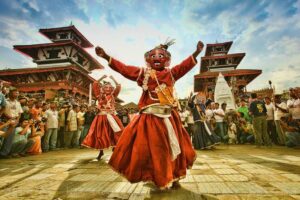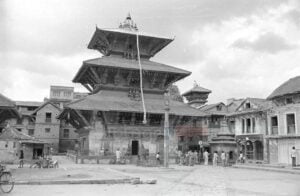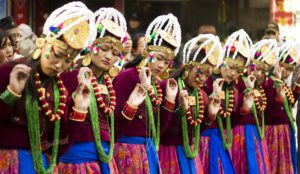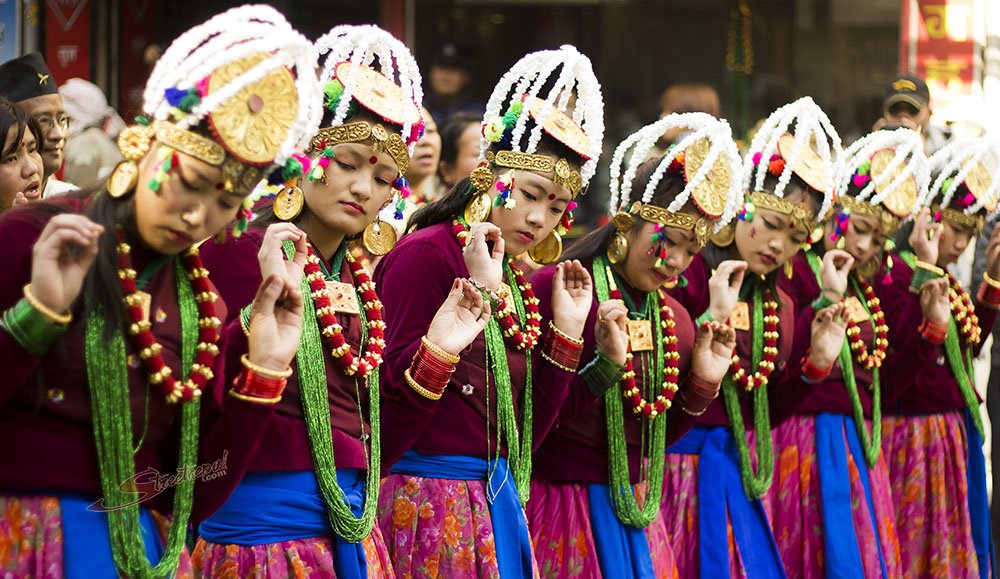Welcome to Nepal
The ancient cultures of Nepal are a source of unique experiences, as they are set against the world’s most stunning landscapes. If you’re seeking a truly captivating and authentic experience, Nepal is the place to go. Come and experience the stillness, slumber, and unexplored.
Nepal’s diversity is unmatched, with activities ranging from the steamy jungle and Terai to the frozen summits of some of the world’s most iconic mountains. The most famous activities in Nepal are trekking, climbing mountains, and rafting in breathtaking landscapes. The only limit to activities in Nepal, from trekking to a micro-light flight through the Himalayas, is your imagination. The Asiatic rhinoceros and the Royal Bengal Tiger can be found in Nepal, which is one of only 15 National & Wildlife Parks in the world, including two UNESCO Heritage sites. Nepal’s inhabitants are its most significant feature. The uniqueness of Nepal lies in the traditions and renowned hospitality of its diverse communities. Nepal’s populace is consistently hospitable, from isolated mountainous areas to medieval hill towns and the ancient cities of the Kathmandu Valley. Nepalese cuisine is a melting pot of flavors and love, whether you’re celebrating it at yearly festivals or trying some cooking demonstrations with your loved ones. Despite having more festivals than days of the year, Nepal has the most festivities in the world. Nepal’s economy is heavily dependent on tourism. It is a significant contributor to foreign currency and income. With 8 of the world’s tallest mountains, Nepal is a popular destination for mountaineers, rock climbers, and adventure seekers. Nepal’s Hindu, Buddhist, and other cultural heritage sites, as well as the fair weather, are all major attractions. Nepal is home to Mount Everest, the tallest mountain in the world, and it is also where Gautama Buddha-Lumbini was born. Adventure tourism and ecotourism, including mountaineering, are significant draws for tourists. Religious pilgrims of all kinds can find other significant locations across the country. In 2012, Nepal Tourism Board (NTB) data showed that 598,204 foreign tourists visited the country through air. Nepal’s tourism industry was mandated to celebrate the start of 2011 as it aims to bring in one million foreign visitors in 2011. The tourist industry is regarded as a means of alleviating poverty and improving social justice in the country.
Wilderness tourism
The Terai region in Nepal is known for its abundance of wilderness and adventure activities, including, paragliding, and bungee jumping.
Religion site
Nepal is a community that embraces diverse religious beliefs. Kathmandu is a hub of Hindu pilgrimage and tourism, with the Pashupatinath Temple being one of the most important Hindu religious landmarks in the world. Among the other places of pilgrimage sites, are the temple complexes in Swargadwari, Lake Gosainkunda, Devghat, Manakamana temple, and Pathibhara.
Another major religion is Buddhism. The birthplace of Gautama Buddha, Lumbini, is a significant pilgrimage destination and World Heritage site. Swayambhunath, the Monkey Temple, is a well-known Buddhist site in Kathmandu. Hindus and other religions worship in Dang Valley. Among the temples in Chhillikot Hill are Kalika and Malika Devi, Ambekeshawori temple, Krishna temple (Kamiyama), and Dharapani temple. The Dang district is home to sanctuaries. A visit to Chillikot Hill and the ancient royal palace is a great way to see both. Both Hindus and Buddhists worship at Muktinath. In the Mustang district, the location is in Muktinath Valley.

Tourism Activity in Nepal
Mountain Climbing
With eight peaks that rise above 8,000m, including Mt., the Nepal Himalayan is the highest in the world at an elevation of 800 km. The Everest. Since 1994, when Nepal Himalayan opened its peaks to climbers, the drama of success and failure has made it an ideal environment for thousands of men and women to undertake the ultimate challenge. Numerous individuals, including saints, philosophers, and researchers, have been drawn to the Nepal Himalayan.
Tracking
The most ideal way to discover Nepal is by walking through its unmatched natural beauty and cultural riches. Walking on unpaved or untamed roads is possible. In either case, the experience will be unforgettable. Along with orthodontic forests, isolated villages, and small mountainous settlements, diverse wildlife such as birds, animals, temples or monasteries, and breathtaking scenery, you’ll also come across friendly locals of all cultures, providing an intriguing glimpse into everyday life.
Watching Bird
With over 646 species of birds, Nepal is a bird-watching destination, with almost 500 hundred of them found in the Kathmandu Valley alone. Kathmandu’s top bird-watching destinations include Phulchoki, Godavari, Nagarjun, Bagmatiriver, Taudaha, and other popular locations. Get your binoculars and enjoy the view.
Kayaking/Rafting/Canyoning
Rafting is a highly effective means of exploring the natural and ethno-cultural heritage of the country. Rafting and canoeing are popular pastimes on Nepal’s many rivers. You can enjoy serene jade waters and breathtaking scenery, or take a walk in rapids with expert guidance from government-approved river authorities. It is possible to have a day of river running or more. The government has made certain sections of 10 rivers available for commercial rafting. The Trisuliriver in Nepal is a popular choice for rafting enthusiasts. The Kali Gandaki offers five days of rapids amidst distant canyons and deep ravines. 26km of white water is the BhoteKoshi, and four days of continuous whitewater can be experienced at the Marshyanghi. The Karnaliriver is renowned for its challenging rapids. The Sun Koshi, a substantial river that spans 27km and takes 8-10 days to reach, is the ultimate test. rafting agents provide world-class services to adventurers. Here, agencies provide life jackets, camping gear, and the typical rafting equipment required for world-class routinization. Nepal has made cannoning a highly sought-after sport in Europe.
Hot Air Ballooning
The Kathmandu valley and the Himalayan ranges are visible from the top, making hot air ballooning a popular tourist activity. During clear weather, one can enjoy a breathtaking view of the Himalayan mountains from 6000m above and the valley itself.
Bungee jump
A bungee jump can now be experienced in Nepal at one of the most exceptional sites in the world. Nepal’s first bungee jumping site can be found at 160m. Above the BhoteKoshiriver, urging you to experience the ultimate adrenaline rush in the stunning surroundings. The 160m jump. It is staffed and run by some of the best jumpmasters in the business.
Paragliding
Nepal’s paragliding is an excellent and enjoyable option for those who are passionate about adventure. You’ll glide through the most breathtaking landscapes on earth, interacting with flying animals such as Himalayan griffins, voles, and eagles.
Ultralight Aircraft
The skies are clear of the lakes, mountains, and villages as planes take off from Pokhara. It’s a perfect way to get. Due to its proximity to mountains and beautiful lakes, the Pokhara Valley is a suitable location for light aircraft. If you were destined to learn how to fly birds as a child, this flight is essential. This flight is essential, even though it may be lonely at the summit. Despite the loneliness at the peak, the breathtaking scenery makes it all worthwhile. From September to June, flights are available at the Pokhara airport. Between sunrise and 11 a.m., the flights are conducted. A. Starting at 3 pm. A. The sun goes down every day during these months.
Mountain Biking
Mountain biking is the optimal way to explore the Kathmandu Valley. Nepal’s varied topography is a dream come true for those who love mountain biking. A green alternative to mountain biking is to explore this stunning nation, its landscapes, and its cultural heritage. Nepal boasts numerous unclean roads and trails that can satisfy the wildest fantasies of every mountain biker. If you want to explore both urban and rural areas of Nepal, mountain biking is a must-have activity. Exciting individuals can embark on extended journeys to exotic locales like Namche Bazaar and western Nepal. It is possible to travel across Nepal’s plains. In Nepal and nearby cities, bicycle rental outlets offer mountain bikes for rent at various locations either day or night.
Jungle Safari
Nepal’s Terai region boasts numerous national parks that draw tourists from all over the world. A journey to these parks involves game-watching with a range of devices, including foot, dugout canoe, jeep, and elephant back. It’s a common sight to spot horned rhinos or two at every elephant safari. Along with rhinos, wild boars and samburs are frequently seen alongside spotted deer, sloth bears, and four-horned antelope. You may be surprised by the majestic appearance of a Royal Bengal tiger.
Mountain Flight
No other experience can match the thrill of flying over the highest mountains on earth, except for a momentary silence. Flights to mountain flights provide the closest view of Mt. Kanchenjunga, Everest, and the Tibetan Plateau. The mountain flights are a popular tourist activity in Nepal and cater to all types of travelers. If time or other factors prevent you from undertaking a trek, these flights provide soaring views of the Himalayas within an hour.
Rock Climbing
The list of stone walls in Kathmandu is a must-visit destination for those who love heights. Recently, rock climbing has gained popularity in Kathmandu, and there are some excellent places to participate. This sport can be tried in Nagarjun, Balaju, Shivapuri, and Budhanilkantha.
History of Nepal

The Gopalas and Mahishapala are believed to have been the first rulers of Kathmandu Valley, with their capital located in Matatirtha, the south-west corner. From the 7th or 8th century B. A. The valley is reputed to have been ruled by the Kirantis. In the epic, ‘Mahabharat’, their famous King Yalumber is even mentioned. Around 300 A.D. occurred. D. The Lichhavis, who came from northern India, defeated the Kirantis. The Changu Narayan Temple near Bhaktapur, which is a UNESCO World Heritage Site (Culture), is one of the Lichhavis’ legacy from the 5th Century. Amshuvarma, the first Thakuri king in the early 7th Century, was succeeded by his Lichhavi father-in-law. He established positive connections with Tibet by marrying his daughter Bhrikuti to the renowned Tibetan King Tsong Tsehen Gampo. Although the Lichhavis brought art and architecture to the valley, the onset of creativity’s golden age occurred around 1200 A. The Mallas and D.
The Mallas erected many temples and magnificent palaces with picturesque squares during their 550-year reign. Society and cities were well-organized during their reign, with religious festivals being introduced and literature, music, or art being promoted. After Yaksha Malla’s passing, the valley was split into three kingdoms: Kathmandu (Kantipur), Bhaktapur (Bhadgaon), and Patan (Lalitpur). Approximately 46 independent principalities were split into Nepal during this period. Gorkha was a kingdom that was under the rule of the Shah. The history of Kathmandu Valley was recorded by Capuchin friars who lived in the valley during their travels from Tibet.
In 1769, Prithvi Narayan Shah, an ambitious Gorkha King, launched a conquest that resulted in the destruction of all the kingdoms in this valley (including Kirtipur which was still independent). The Shah dynasty, established by Prithvi Narayan, replaced the Gorkha kingdom by moving their capital to Kathmandu and ruling over it as the ununified Nepal from 1769 to 2008.
Dravya Shah founded the Gorkha state in 1559, establishing a kingdom in an area primarily composed of Magars. In the 17th and early 18th centuries, Gorkha underwent a gradual expansion, conquering various states and forming alliances with others. The Kathmandu Valley was a passion of Prithvi Narayan during his early years. Due to the threat posed by the British Raj in India, he expelled European missionaries from the country and isolated Nepal for more than 100 years.
The Shah king was reduced to mere figurehead status when Jung Bahadur Rana became Nepal’s first prime minister in the mid-19th Century. He initiated a hereditary regime of the Rana Prime Ministers that lasted for 104 years. The Ranas were overthrown in a democratic movement led by King Tribhuvan, the then monarch of Nepal, in the early 1950s. Following the Ranas’ removal, King Tribhuvan was reinstated as the Head of the State. A new constitution was issued by King Mahendra in early 1959, and the first democratic elections for a national assembly were conducted. The Nepali Congress Party emerged as the winner and Bishweshwar Prasad Koirala assumed office as prime minister. King Mahendra dismantled Parliament in 1960, dismissing the first democratic government.
They found the courage to launch a People’s Movement in 1990, following years of opposition and political party prohibition. To promote democracy, King Birendra acquiesced to constitutional reforms and established parliamentary governance with the King as the Head of State and an executive Prime Minister. The first parliamentary elections in Nepal were held in May 1991. Maoist parties initiated the People’s War against the monarchy and the elected government in February 1996.
A terrible tragedy claimed the life of King Birendra, Queen Anne, and many members of her family on 1st June 2001. He was crowned as the king, and only his brother Gyanendra and his family survived. King Gyanendra backed the elected government for a while but then withdrew from the Parliament to assume absolute power. Kathmandu was the center of attention for a 19-day curfew after the democratic parties launched another People’s Movement in April 2006. Ultimately, King Gyanendra gave up the power to govern the Parliament. On November 21, 2006, Prime Minister Girija Prasad Koirala and Maoist chairman Prachanda signed the Comprehensive Peace Agreement (CPA) 2006 pledging to “… support for democracy and peace for the development of our people and this country.” A Constituent Assembly election was held on April 10, 2008. Nepal’s Constituent Assembly voted to transform it into the Federal Democratic Republic on May 28, 2008, effectively abolishing the monarchy that had been in existence for 240 years. Today, Nepal has a President as its Head of State and Deputy Prime Minister.
In the first 4 years of the Constituent Assembly’s power, the assembly made significant progress in completing the task of writing a new democratic constitution for Nepal. A massive democratic exercise was carried out in the country, involving public consultations on the new constitution’s contents and intense discussions in front of the Assembly. Due to political disagreements on controversial issues such as federal provinces and government, the first CA was unable to complete its historic task, leading to the termination of its mandate in 2012. During the November 2013 election, CA II’s leadership determined that it would take one year to write the new constitution after its first meeting.
A destructive earthquake of 7. The year 2015 saw a devastating earthquake in Nepal, which caused significant damage to the country’s infrastructure and property. Most of the hilly regions in Nepal, including the Kathmandu Valley, were severely affected. Following the dreadful experience, political parties felt compelled to speed up the constitution’s writing so that post-destructive reconstruction efforts could take precedence.
Political parties resolved most controversial issues within weeks, leading to the finalization of the constitution. CA members overwhelmingly voted to approve the new constitution of Nepal on 20 September 2015. The Nepali people’s long-standing desire for a representative body to create governing bodies has been realized with this significant achievement. The new constitution has resulted in the successful elections of the new President, Prime Ministers, and other State positions.
Culture & Society of Nepal

Nepal has an exceptionally rich culture. Over the course of centuries, Nepal’s cultural legacy has developed. Nepal’s diverse ethnic, tribal, and social backgrounds are reflected in its multifaceted heritage, which includes music, dance, art, folktales, languages, literature, philosophy, religion, festivals, celebrations… and food.
Dance And Music
According to legend, the tandava dance was first performed in the home of Lord Shiva in the Himalayas and Nepal. This suggests that Nepali dance has a rich history. The dance styles and costumes of Nepal undergo slight changes in regard to ethnicity and altitude. The Dishka is a wedding dance that involves intricate footwork and arm movements. The themes of harvesting, marriage, wars, a lonely girl’s love, and various other stories from everyday life in the villages are featured in accompanying music and musical instruments.
Literature & Language
According to the 2015 census, 123 languages are spoken in Nepal. The three major language groups that have developed in Nepal are Indo-Aryan, Tibeto-Burman, and indigenous. The primary language of Nepal, with a rate of 44 percent, is Nepali. Maithili (11%) and 6% each. 7%), Bhojpuri (6%), and Tharu (5.0%). 8%) and Tamang (mean). Nepal Bhasa (3%) and 1%). 2%, Magar (3%) and Bajjika (3%) were the remaining groups.
Nepali is the official national language and, with Devanagari script, serves as the lingua franca among ethno-linguistic groups in Nepal. Maithili, which originated in the Mithila region of Nepal, is the official language of both Nepal and Madhesh. Nepal has a second language, Maithili. The languages of Nepal that no longer exist are Kusunda, Madhesiya, and Waling.
Religion and Philosophy
80 individuals were recorded in the 2001 census. 6% of the population follows Hinduism. Roughly 11% of the populace practiced Buddhism, even though those identified with Hinduism or Buddhism often follow a combination of other religions and spiritual practices. Roughly 3. Only 2% of the population follows Islam, while 3. The Kirant religion is practiced by 6% of the population. Christianity is observed by a minority of 0. 5%.
Nepal has a history of over 2000 years of Hindu and Buddhist traditions. In Lumbini, Buddha was born, and Pashupatinath temple in Kathmandu is a famous Hindu Shiva temple that is old. Nepal boasts several temples, Buddhist monasteries, and places of worship for various religious sects. Nepalese philosophical thought has traditionally been infused with the Hindu and Buddhist philosophical ethos and traditions, including contributions from the Kashmir Shaivism, Nyingma school of Tibetan Buddhism, Karmacharyas of Bhaktapur, and tantric traditions. In Nepal, there are numerous tantric practices that involve the sacrifice of animals. The sacrifice of five types of animals, always male, is acceptable: water buffalo, goats, sheep, chickens, and ducks. The sacred nature of cows makes them unsuitable for sacrifice.
Festival and celebration
Several of Nepal’s festivals last for several days. Dashain is Nepal’s most significant festival and one of its lengthiest. Typically, Dashain is celebrated during the monsoon season’d ends in late September and mid-October. Today is a day of triumph over the demons. The Newars commemorate Mohani. Tihar or Swanti and Chhath are two of the significant festivals in Nepal. The lunar calendar’s Nepal Sambat observes New Year’s Eve.
Among the significant festivals are Buddha Jayanti, the celebration of Buddha’s birth, and Maha Shivaratri, where people often consume excessive alcohol and smoke charas. The Sherpas at Mani Rimdu, a destination in the Mount Everest region that is much higher, celebrate for the greater good of mankind.
Festivals often feature dance and music, and a diverse range of food options are available during special events.
In Tantric tradition, the Sagan ceremony involves offering five food items to a person for good fortune, such as boiled eggs, smoked fish, meat, lentil cake, and rice wine.
Map of Nepal


6 thoughts on “Nepal Tourism”